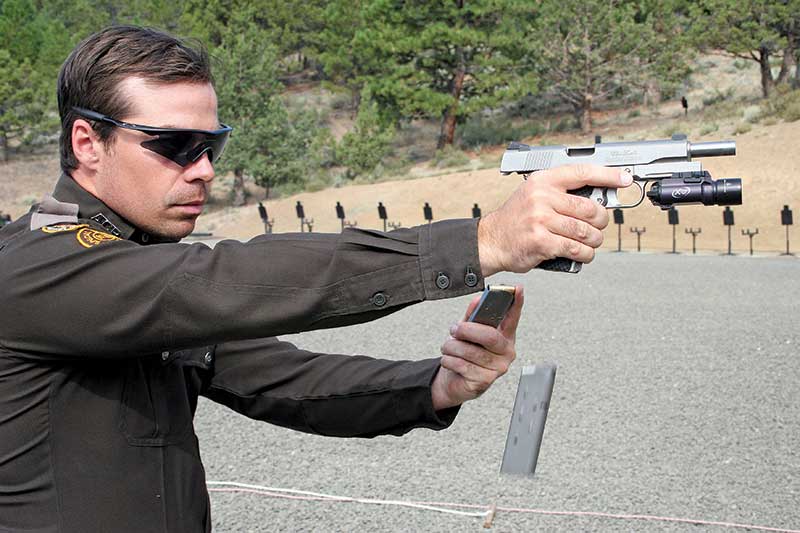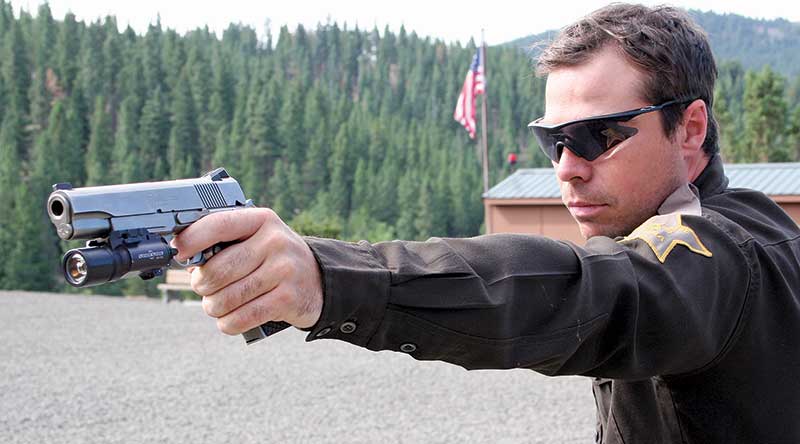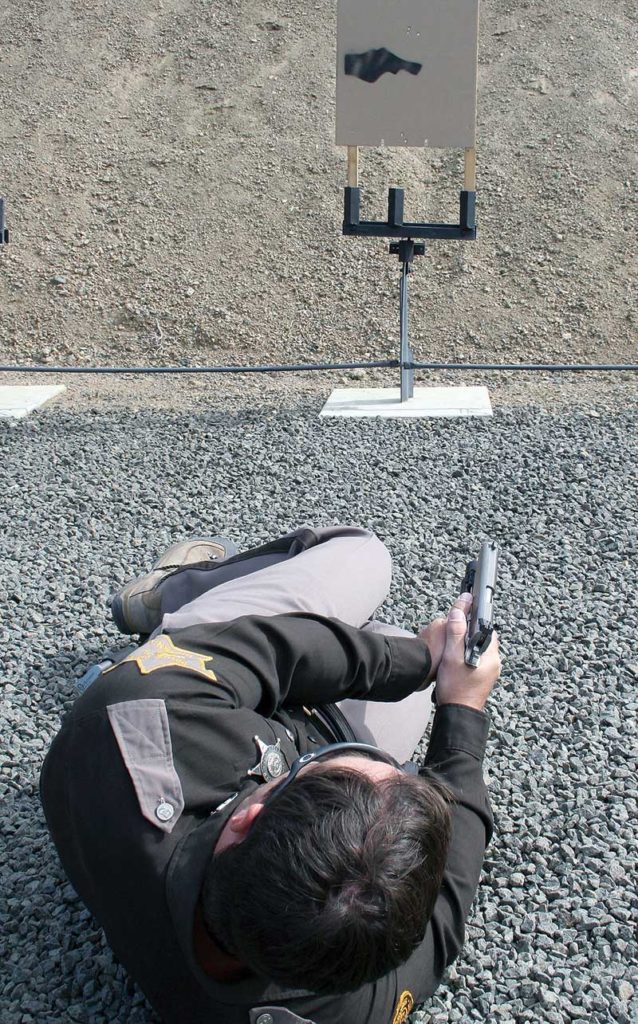
ACMA10_4_1-800
It’s a constant mantra for American police, “Do more with less.” Today, with officers taking pay and benefit cuts it can be trying for LEOs to stay motivated and focused on training. Addressing personal fitness some-times does not garner the attention it deserves for individual officer safety. Firearms and tactics training, which are almost always on the short end of the money stick, also take a solid smack in the mouth as the money crunchers manipulate money away from training to new light bars or something. It’s true there are many problems, but there’s also a need to consider moving forward. In that vein I thought to give you an example of a training block individual officers could implement at the range taking into consideration the limited supply of everything these days.
SAFETY
Although the forums are overflowing with experts who declare the use of the four fi rearms safety rules are archaic, a hell of a lot of people have used these rules to train thousands of people — safely. It’s darn hard to have something go wrong and not violate one of these four rules. It begs the question … how many people do you or would you trust behind you with a loaded gun from your agency? So love ‘em or leave ‘em, the rules work for the range and they work in a fight.
1. Treat all guns as if they are always loaded.
2. Do not point the muzzle at anything you are not willing to destroy.
3. Keep your finger off the trigger until your sights are on target and you are willing to shoot.
4. Be sure of your target and backstop.
SETUP
Dry practice is valuable especially if it’s done dry without ammunition. Apply the four safety rules and unload the gun in a safe direction before moving forward with a practice session.
DRAWING
No matter how good of a shot you are, you cannot shoot until you get the gun out of the holster — so that makes this action sort of important. The fastest draw is to have the gun in your hand to start with so there you go. With the retention systems of today you need to practice drawing to assure if the pistol is really needed you’re up to the drawing task. Draw the pistol smoothly, the speed everyone’s in pursuit of comes with time and repetition. Drawing fast is related to shooting fast and as of today I can find no one who ever saw a stop watch in a fight.
Re-holster (also smoothly), remembering in your world you may be required to re-holster without looking at your gear and doing so with only one hand as the other may be busy doing stuff. Over the years many incidents of people accidentally shooting the gun have occurred while holstering the handgun not drawing.
READY
A defensive posture, the ready in your world, should be based on your environment, not a specific technique. I would keep the gun between you and the threat. Logic would dictate you not lead the muzzle around corners, and if in close proximity to bad people you’d be well advised to create some distance away from these threats.
SINGLES AND TRIGGER RESET
After loading the handgun safely from the ready bring the handgun on target and press the trigger carefully while aligning the sights. As the pistol fi res maintain rearward pressure on the trigger. After the pistol fi res reconfirm the front sight and carefully let the trigger move slightly forward until it clicks or resets. After it resets an arch nemesis, the trigger “slack,” is out so confirm the sight and press carefully as required. This is a marksmanship exercise and I’ve never seen a tight group win a gunfight — but good placement is comforting. Since you’re shooting you might as well shoot good.
RIGHT HAND
This can be done from the ready or from the holster and eventually you should do both. Drawing smoothly, roll your right shoulder forward “behind” the handgun, as it were, and carefully press the trigger. Auto pistols are recoil operated and recoil guns work best if they have solid resistance. The pistol for a right handed person may have a slight lean left on the sight picture and this is mostly due to the natural curve of your arms so I simply don’t fight, I just roll the shoulder forward and try to use the sight as well as I can.
The sight lean thing is for right-handed applications. In the left hand, the sight may lean to the right, but not to worry the shoulder rolling behind the gun helps to reduce recoil and add control. Left hand, or off-hand for most of us who are right-handed, access to the holster or developing a way to get access to the holster needs to be considered.
Unsnapping belt keepers and rotating the belt on the waistline to bring the holstered handgun to the working hand should be considered. Most of this stuff concerns injury so it might be addressed from ground positions or there may be a need for consideration for a second gun with easier access for the left hand. If there’s a question about doing this safely as you learn to do this stuff, use an unloaded gun so as to limit the blood stripe potential on your lower leg. More than one cop has killed himself by accidentally shooting himself in the legs and groin area.
EMPTY LOAD
Bluntly, I’d shoot the handgun in a fight until I won or it went empty. Empty guns themselves are not so much bad luck — it’s what’s done with the gun when it’s empty. I would keep the muzzle in the direction of the target and reload while watching the threat instead of eye humping the magazine well. It’s beyond foolish if you don’t know where the magazine well is on a handgun you’re planning on saving your life with. I understand, to a degree, competition and “looking” at the well. I don’t understand looking for a threat most of my life and then taking my eyes off said threat while a fight is going on. Logic and reality will advise you not to put your unprotected head up in a fight and it’s a self-curing problem if done while gun fighting. You’re not training for a competition though …
MALFUNCTIONS
Most malfunctions come from the operator, the choice of ammo or magazines. I would not train to throw away partially loaded magazines. If the magazine was bad to start with it should not have been in the gun. If the gun fails to fi re I would tap the magazine base to confirm proper seating, cycle the action to load the gun or clear obstructions and fi re. If it does not fi re, unload it and reload and shoot as required. I would not tip or roll the gun to “clear or help” the extraction/ejection process. The gun was upright and ejecting just fine until it quit running and it was cycling fine without the roll.
The pistol has three apertures: mag well, ejection port and muzzle. The magazine well is the biggest opening, remove the magazine from the pistol and cycle the action and let the crap “flush” from the bottom. Stylized techniques are okay if you can confirm you’ll always fight with your gun … otherwise these actions will clear all the pistols on the planet you can take the magazine from.
HEAD SHOT
The headshot by LEOs is the most important single shot they will ever fi re. LEOs would never shoot this shot unless everything they fi red into the body of the threat had not worked and the threat was still coming — or it was the only avail-able target to them. The headshot must, in practice and in application, always be perfect — always.
ZONE SHOTS
Humans have three armored zones: the head, the chest and the pelvis. The pelvis is the biggest bone structure and the area that moves the least if the threat is moving, which it often is in a fight. At short range if a fight started the pelvis is easier to hit and heavy in structure. The head, on the other hand, is smaller, armored of a fashion and moves a lot. The closer it is to you the more the range of motion there is.
Historically, we never shot the center of mass “because it was good,” we shot it because it was big; and the old “tactical” center of mass had the same issue as the head as far as excessive upper body movement. A good plan of personal defense would include all three zones as they might be available.

Empty loads are a reality of gun fighting. Loading the pistol while the muzzle is be-tween the officer and the threat is a good concept.

Practice the draw stroke, as it is essential to personal defense for police officers, especially with retention holsters.
RIGHTS & LEFTS
Leaning right or left over imaginary lines representing corners, doorways or cover allows the shooter to use protective cover while getting the most access to the target. Every attempt should be made to minimize yourself as a target. People will shoot you because they see you; they see you because you let ’em. The days of standing clear of cover or concealment should be long over. The other side has figured out they can shoot through stuff and they’re doing it everyday.
LATERAL MOVEMENTS
Lateral movements comprise a large part of movement both for access to the target and/or to get to protective cover. Large lateral steps are valid if moving to cover in the BuzMart parking lot while being shot at. Smaller lateral steps might be more valid while moving quietly to contact on a building search so as to not give the threat a shot at your legs.
LET THERE BE LIGHT
Officers should be up to speed with both gun-mounted lights, if used, and hand held lights. There is much emphasis on the CDI stuff while in reality I give a zip whether or not the light strobes. A light that turns off and on and an officer who knows how to turn it off and on is a good thing. Turning the light on could make you a target, but is probably better than not having a light on and shooting your partner in the semi-dark recesses of a hallway. Using lights is damn dangerous for cops as well as applying any type of tactics to any environment. I would still rather know what I was shooting be-fore I turned the gun on.
GROUNDED
Always a possible part of fighting, especially for cops, is being on the ground. LEOs should know how to and be trained in drawing and using their guns from a ground fighting mode. Fistfights often turn into gunfights and possible gunfights turn into fistfights — you’ll have to be able to do both well.
TRANSPORTATION
Mobility is an issue as it is — how LEOs get where they go, so they can do what they do. Considerations of stop-ping the car (so it doesn’t roll away), disengaging the seat belt (so you’re not trapped in the car), opening the car door (so you can get out) and drawing the gun (without shooting yourself) are all components that need to be practiced and be part of a law enforcement officer’s skills set.
THE COURSE OF FIRE
This course of fi re can be done at any reasonable range and can be used at different distances as skills develop. Dry (no ammo) or live (the loud one, with ammo); do it one way or the other.
Applying the safety rules, draw the pistol from the holster and fi re one round remembering to get a second or follow-through sight picture. Work to press the trigger and reset the trigger without “bouncing” your finger off the trigger. Repeat four times for a total of five rounds.
Draw the pistol with one hand (strong-side) and fi re one round. Remember second sight picture and trigger reset. Repeat four more times for a total of five rounds.
Draw the pistol off-hand (if it’s not possible then draw strong-side and transfer the gun to your off-hand) and fi re one round. Sight follow-through and trigger reset. Holster retention type and size may dictate a strong or off-side draw. Fire five rounds total.
From the ready with only one round in the pistol, shoot the pistol. When the slide locks to the rear, reload by empty load, confirm the sight and shoot one more round. Do this two or three times.
Practice some malfunctions. Unseat the magazine and fi re two rounds. As you know, it will only fi re once then go click. Seat the magazine, cycle the pistol and shoot one more (this is also referred to as tap, rack and shoot). Stick an empty case in the pistol ejection port (also known as a “stovepipe” or type-2 malfunction). The gun will not fire when you try to so cycle the slide and fi re one round.
Place an empty case in the top of your magazine. Fire the chambered live cartridge; when the pistol cycles, the empty case will foul the pistol. Clear it and fi re one round. If you have a range shooting partner have them help you with set ups. Use nine or ten rounds for this part of the drill.
Drawing from the holster or from the ready shoot one perfect headshot. Repeat five times. The headshot needs to be perfect!
Drawing from the holster or from the ready fi re one round in each of three zones of natural armor. You can change the order of delivery but plan on none of them working in a fight and be ready to do it better or again — or go get a bigger gun. Do this three times.
From the holster or the ready, lean way right or way left simulating the use of cover and/or concealment. Do three single shots right and three single shots left.
Do all of the above with a gun-mounted or handheld light as would be feasible.
Practice from the ready or drawing carefully to shoot the parts of this drill feasible from the grounded position.
Practice your manipulations in a vehicle; drawing, seat belts and door openings — dry is best in the beginning — and regardless be careful to control the muzzle.
This is far from perfect but if you practice it a few times it will help with manipulations and marksmanship.
In the world you live, if you are forced to deploy your gun and fire it, nothing will change unless you hit your target.





















